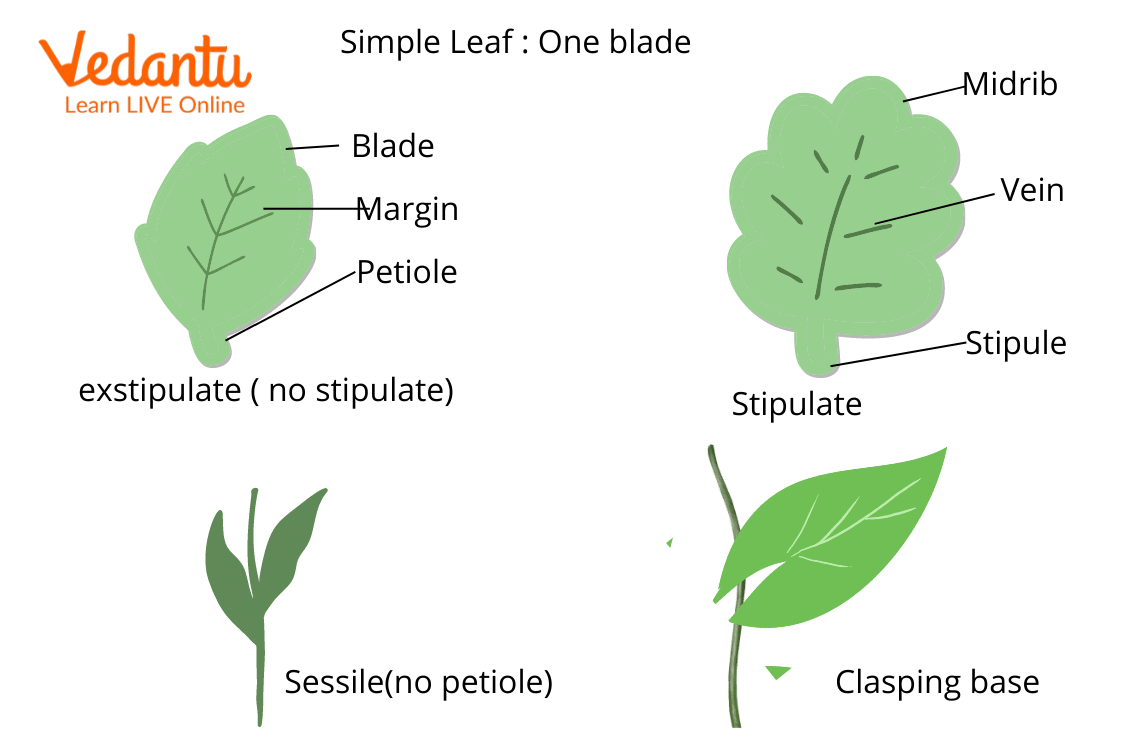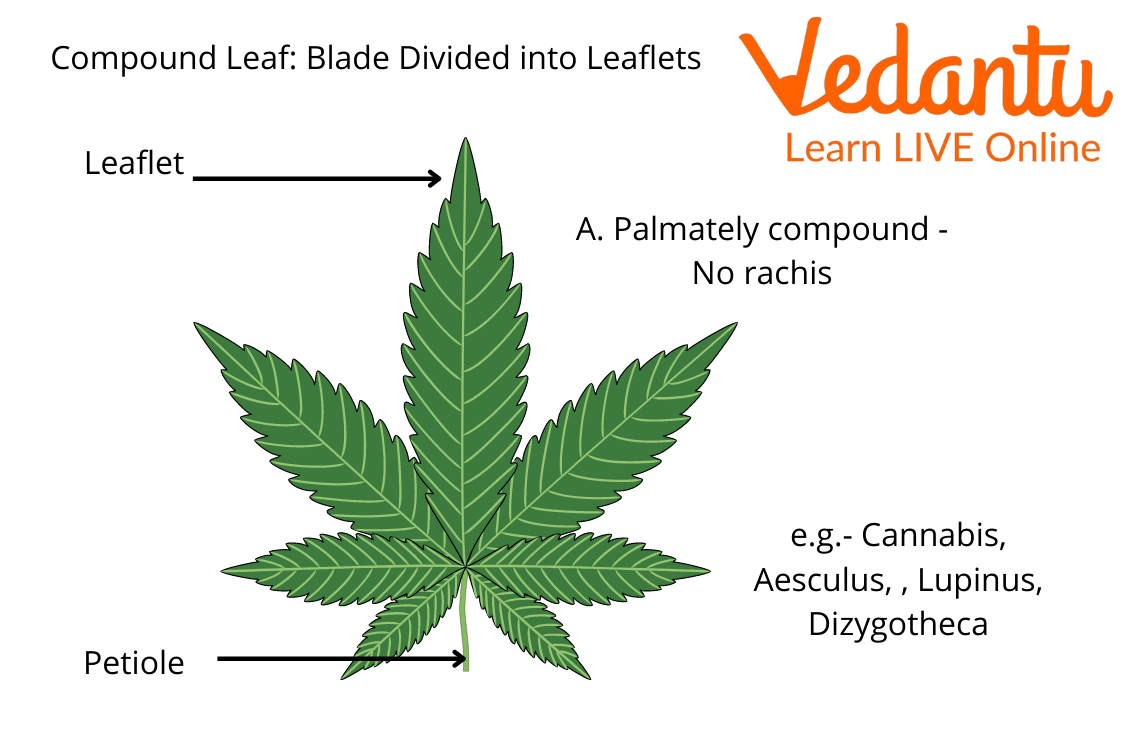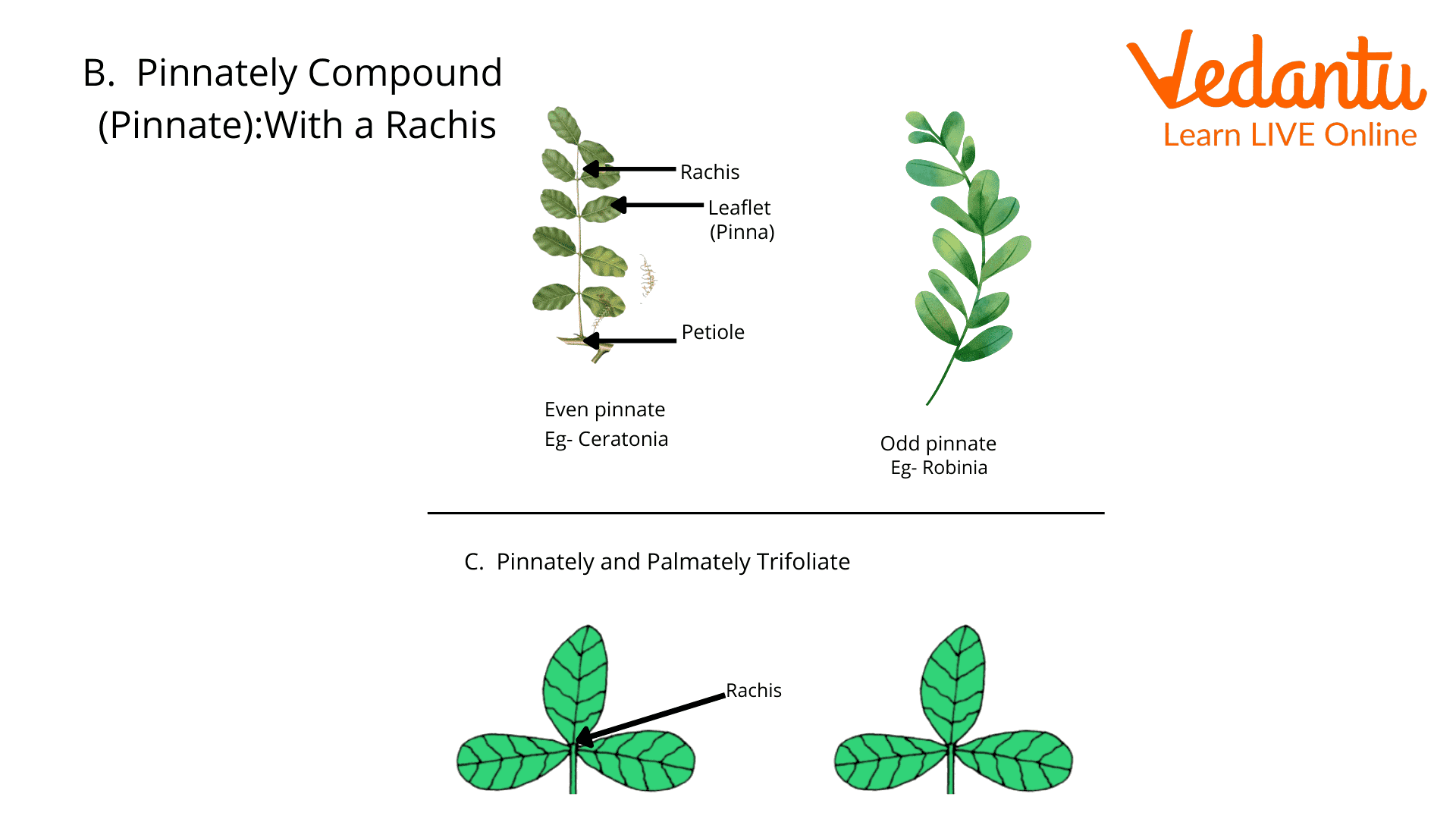How to Identify Pinnate and Palmate Compound Leaves in Biology
Leaves are an essential part of plants. They photosynthesise and produce food for plants. Leaves are mainly of two types, simple and compound leaves. Compound leaves are further classified into two types, mainly pinnately and palmate compound leaves. When we surround ourselves with nature, we are mesmerised by the bright green colour which strikes our eyes. This green colour comes from leaves. Leaves are born on the stem and rise at nodes. Have you ever thought about where the green colours on leaves come from?
Chlorophylls absorb light which allows plants to collect energy from the Sun. As a result, leaves are green because chlorophylls absorb every colour of UV light except for the green colour. When you look closer at leaves have you ever noticed how different they are in shape, size, and texture? There exists a wide diversity between leaves. There are some general characteristics between them but some have unique abilities.
Leaves are built from three main types: the base, the blade, and the petiole. The longest part of the leaf is the blade. The base is known as the region of the blade that attaches to the petiole.
Types of Leaves
Simple Leaves – Simple leaves possess the entire lamina. Even if the lamina is carved, it does not reach the midrib. They do not have leaflets.
Compound Leaves – Compound leaves possess leaflets. The lamina of a leaf is divided into many leaflets and blades.

Simple Leaf

Compound Leaf
What is a Simple Leaf?
A leaf that can not be further divided into any smaller sections or leaflets is called a simple leaf. This type of leaf joins the stem through the petiole.
Structure of Simple Leaves:
Simple leaves consist of four parts:
Leaf Base - It is the expanded area where the stem and leaf connect.
Stipules - The position of the stipule changes depending on the species of the plant. These small bud-like structures are situated near the leaf base.
Petiole - The petiole is the part that adheres the leaves to the stems. Plants can have short, long, or no petioles at all.
Lamina or Leaf Blade - The green extended part of a leaf is called the lamina or leaf blade. This part consists of mesophyll that helps in performing photosynthesis.
What is a Compound Leaf?
Compound leaves are those leaves when the lamina of a leaf is divided into many leaflets. The incision made in the lamina is reached into the midrib which is further divided into multiple leaflets. The leaflets in the compound leaf do not possess buds in their axes.
Compound leaves are of two types:
Pinnate Compound Leaves
Palmate compound leaves
Pinnately Compound Leaf with Examples
In pinnate compound leaves, leaflets are present on the common axis. The midrib is represented by the common axis called the rachis.
Examples: Ash, Hickory, Walnut, Pecan, Black lotus, Neem, Cassia fistula.
There exist three types of pinnate leaf arrangement:
Even-pinnate Leaflet Arrangement: In this arrangement, leaflets are in pairs along the rachis without a single terminal leaflet. This type of arrangement is also known as paripinnate.
Odd-pinnate Leaflet Arrangement: In this arrangement, instead of a terminal pair of leaflets, there is a single terminal leaflet at the top. This type of arrangement is also known as imparipinnate.
Alternate-pinnately Leaflet Arrangement: In this type of arrangement, leaflets are produced alternately along the rachis with a single terminal leaflet. This type of arrangement is also known as aternipinnada.

Pinnate Compound Leaves and Types
Bipinnately and Tripinnately Compound Leaves
Pinnately leaves that further divide are called bipinnately compound leaves. These compound leaves have leaflets from secondary rachises. The axillary buds are actually found in the angle between the petiole and the stem of pinnate leaves, not in the axils of leaflets is the main distinguishing factor to recognize bipinnate leaves.
Even if these leaflets are twice or thrice divided, they all still account for one leaf branching off the stem. Since the leaflets are formed on primary and secondary veins, the leaflets formed are given the name pinna.
Palmately Compound Leaf with Examples
In simple palmate leaf, the leaflets are formed and arise from a single point of attachment called the distal end of the rachis.
Each leaf is a part of an individual leaf and all are branching from the axil part of the leaf. These compound leaves do not have rachises as each palmate branches out directly from the petiole, each petiole may also branch off to other petioles.
Examples: Clover, potentilla indica, oxalis, Silk, and Cotton.
Difference Between Pinnately and Palmately Compound Leaf
Interesting Facts
Leaf cells consist of organelles known as chloroplasts which contain specialised pigments called chlorophyll.
Since leaves do not absorb green colour, they instead reflect it which is seen by our eyes.
Important Questions
What are the two types of compound leaves?
Ans: The two types of compound leaves are pinnately and palmately compound leaves. In pinnately compound leaves, leaflets are present on the common axis and in palmately compound leaves, leaflets are present on the distal end of the rachis.
What are the various parts of the leaves?
Ans: The various parts of the leaves are midribs, axil, stem, leaf base, petioles, vein, venules, tip, and leaf base. Each part of the leaf has a function that is used in the function of the leaves.
Key Features
Just like the name of the palmately compound leaves, the whole leaf is shaped like the palm and fingers of your hand.
Pinnately leaves show the resemblance of a feather.


FAQs on Pinnate vs Palmate Compound Leaves: Differences & Examples
1. What is the main difference between a pinnate and a palmate compound leaf?
The main difference lies in how the leaflets are arranged on the stalk. In a pinnate compound leaf, the leaflets are attached along the sides of a central axis called the rachis, similar to a feather. In a palmate compound leaf, all the leaflets attach at a single point at the tip of the petiole, resembling the fingers of a hand.
2. What is a pinnate compound leaf, and can you give an example?
A pinnate compound leaf is a type of leaf where multiple leaflets are arranged on either side of a central stalk, which is known as the rachis. This feather-like arrangement is a key identifier. A very common example of a pinnately compound leaf is the Neem leaf.
3. What is a palmately compound leaf, with an example from the NCERT syllabus?
A palmately compound leaf is one where all the leaflets are attached to a common point at the end of the leaf stalk (petiole). This structure makes them spread out like fingers from the palm of a hand. A classic example mentioned in biology studies is the leaf of the Silk Cotton tree.
4. Is there an easy way to remember the difference between pinnate and palmate leaves?
Yes, there's a simple trick! For 'pinnate', think of a 'pinna', which is another word for a feather; the leaflets are arranged like the parts of a feather. For 'palmate', think of the 'palm' of your hand; the leaflets spread out from one point, just like your fingers.
5. How is the arrangement of leaflets in compound leaves different from the venation in simple leaves?
This is an important distinction. The terms 'pinnate' and 'palmate' can describe two different things:
- Leaflet Arrangement: This applies to compound leaves and describes how multiple small leaflets are attached to the main stalk.
- Venation Pattern: This applies to the network of veins within a single leaf blade. For example, a simple Mango leaf has pinnate venation but is not a pinnate compound leaf.
6. Why do some plants have compound leaves instead of simple ones?
Compound leaves offer several advantages for a plant. The gaps between leaflets can reduce wind resistance, preventing the leaf from being torn. They may also allow for better light penetration to lower leaves and help in cooling the leaf surface more effectively. Losing a single leaflet is also less damaging to the plant than losing an entire large simple leaf.
7. Can you list some common examples of both pinnate and palmate compound leaves?
Certainly! Here are a few common examples to help you identify them in nature:
- Pinnate Compound Leaves: Rose, Tamarind (Imli), and Gulmohar.
- Palmate Compound Leaves: Silk Cotton (Bombax), a Hand-shaped leaf of the Castor plant, and Cannabis.
8. What is the function of the rachis in a pinnate compound leaf?
The rachis is the central axis that supports the leaflets. Its main job is to hold the leaflets in a position that maximizes their exposure to sunlight for photosynthesis. It also contains the vital vascular tissues that transport water and minerals to the leaflets and carry the sugars produced back to the rest of the plant.










